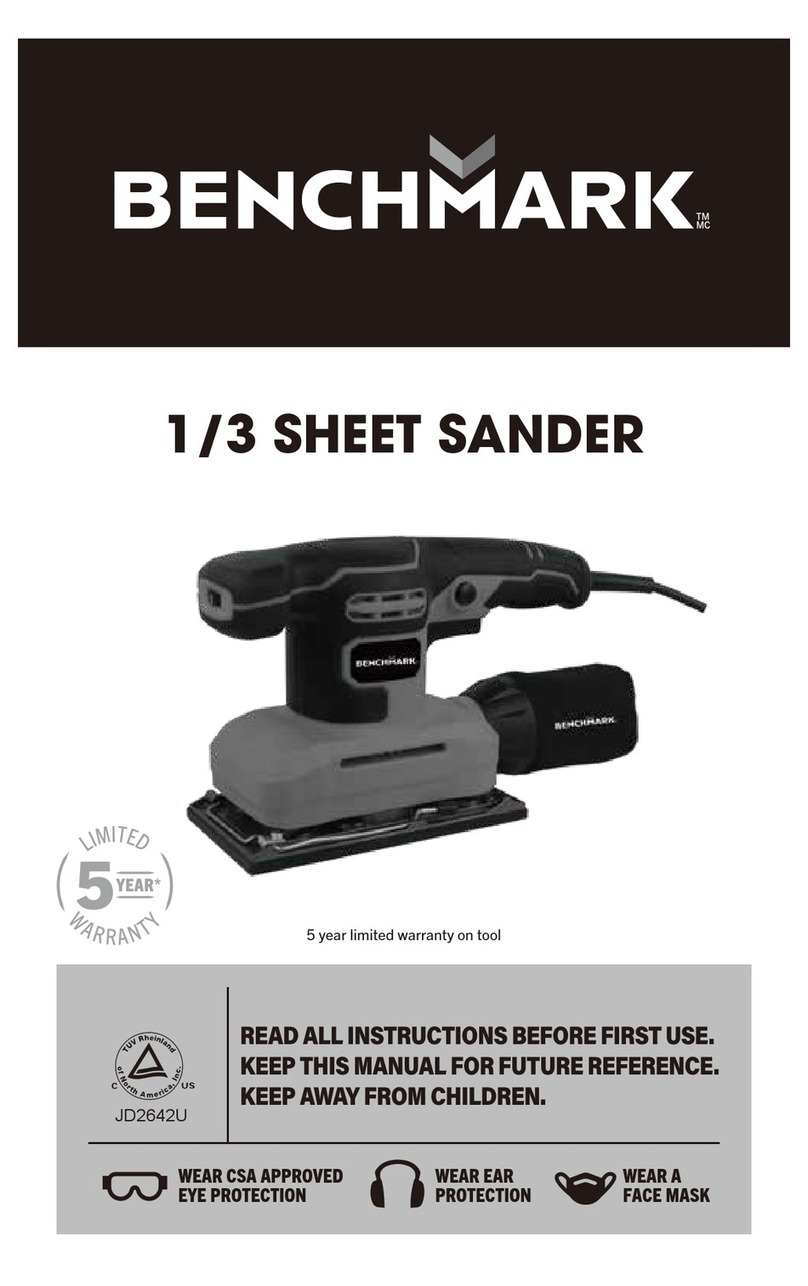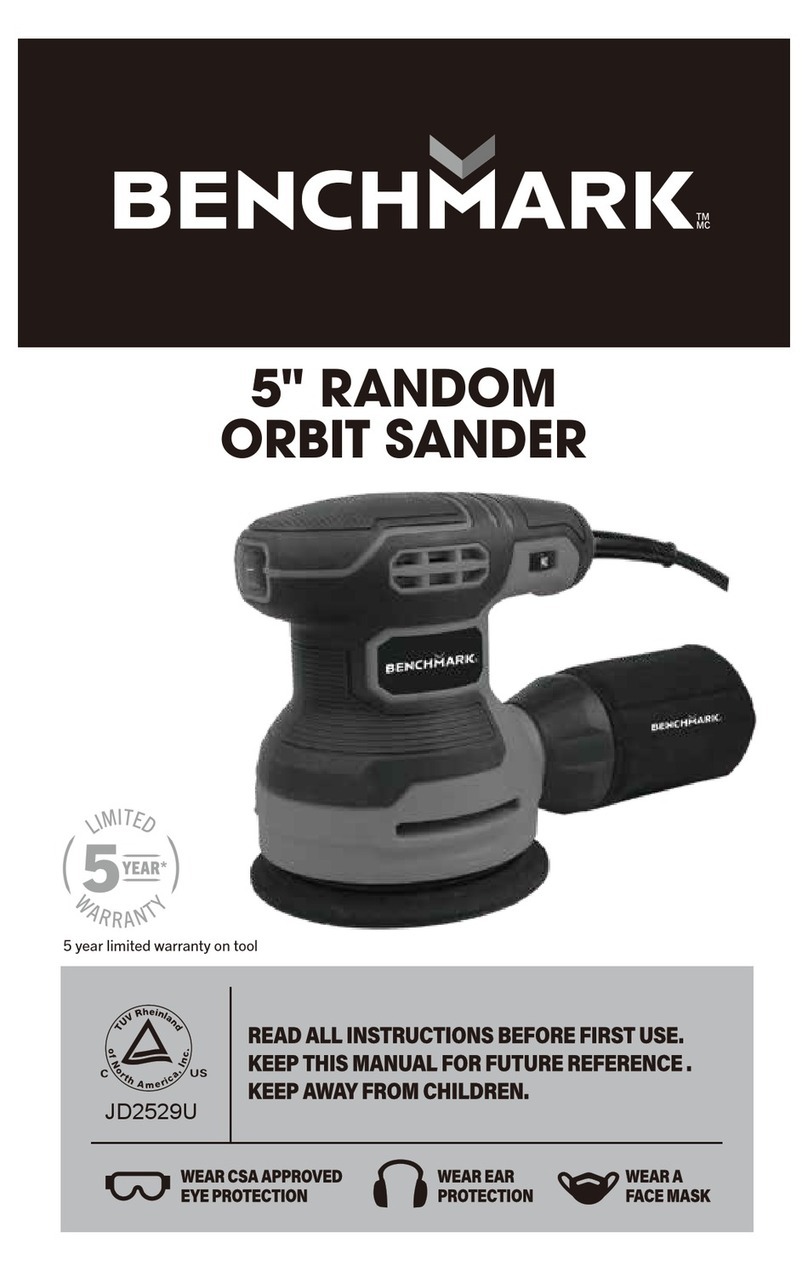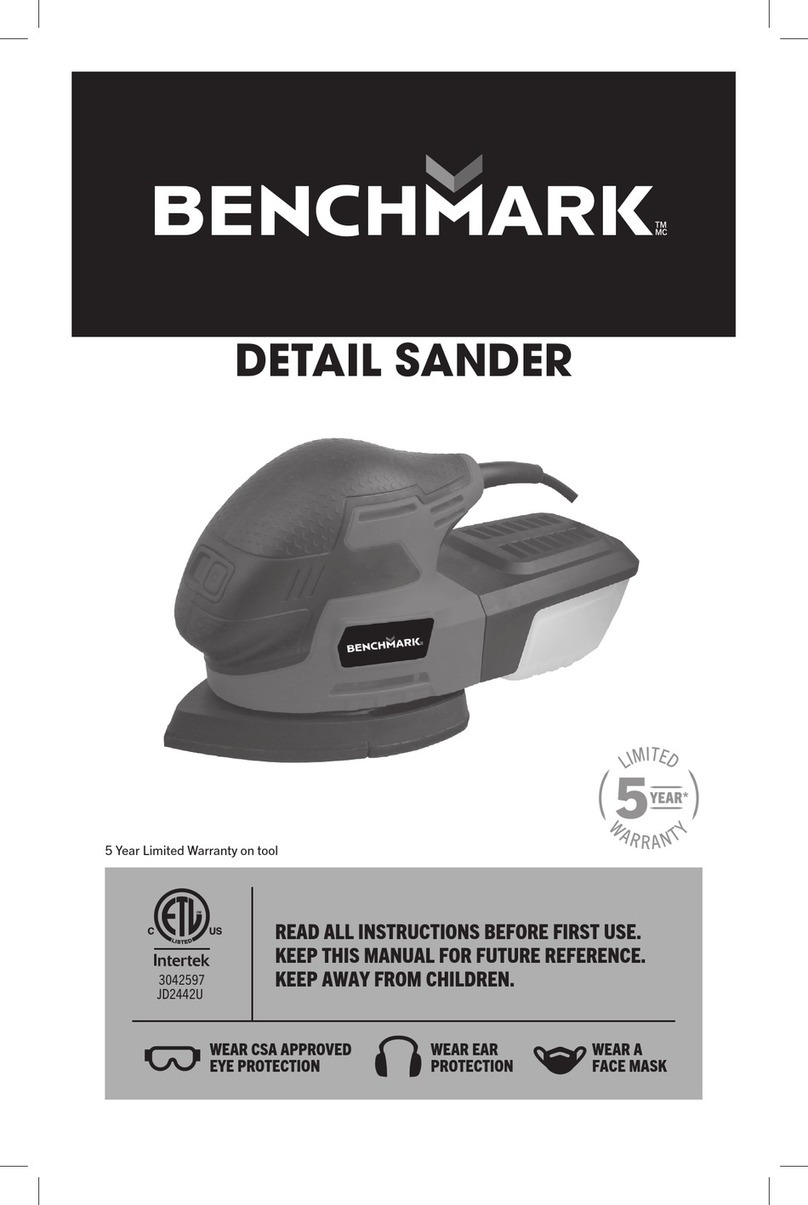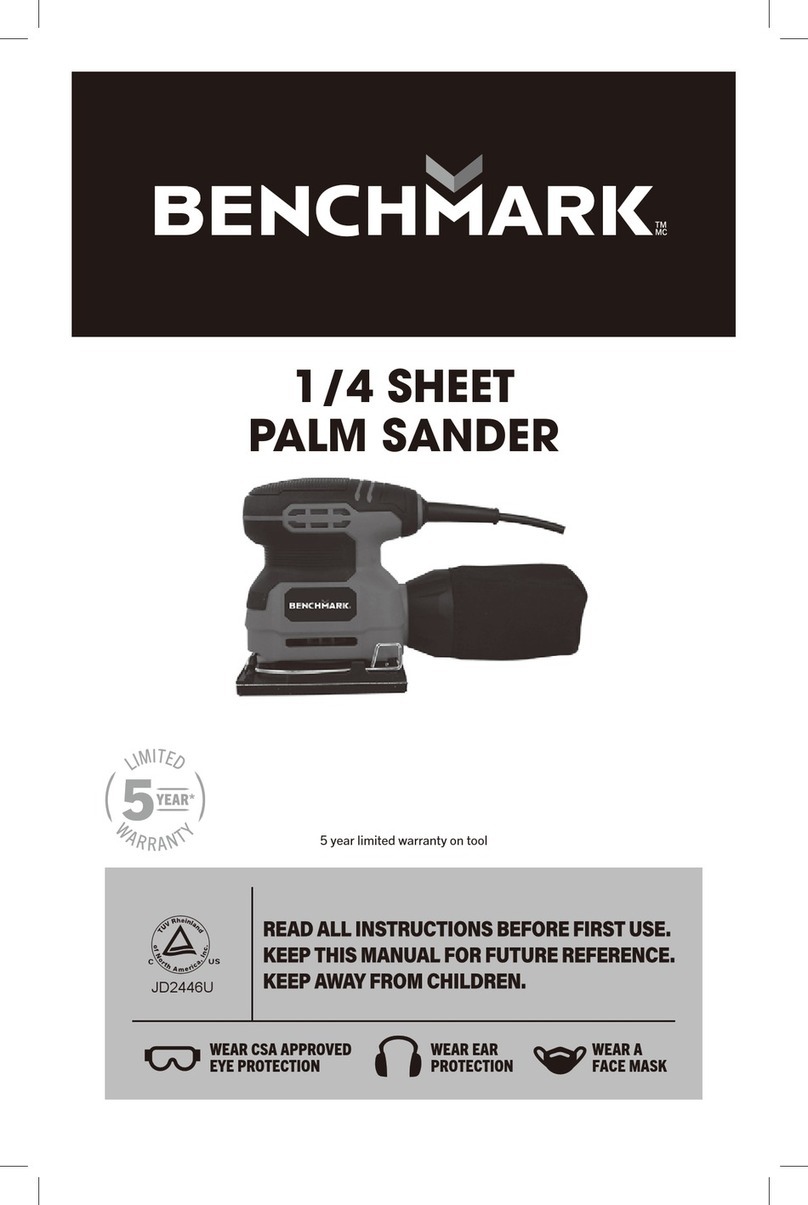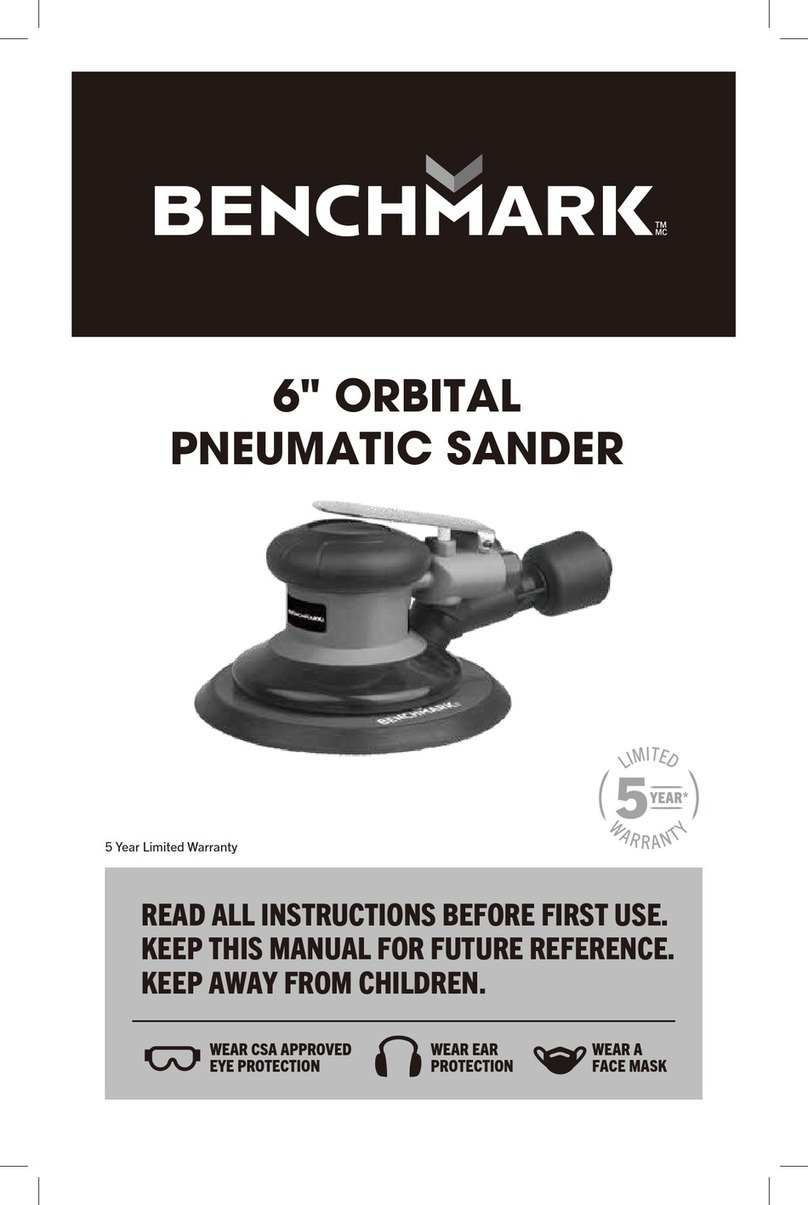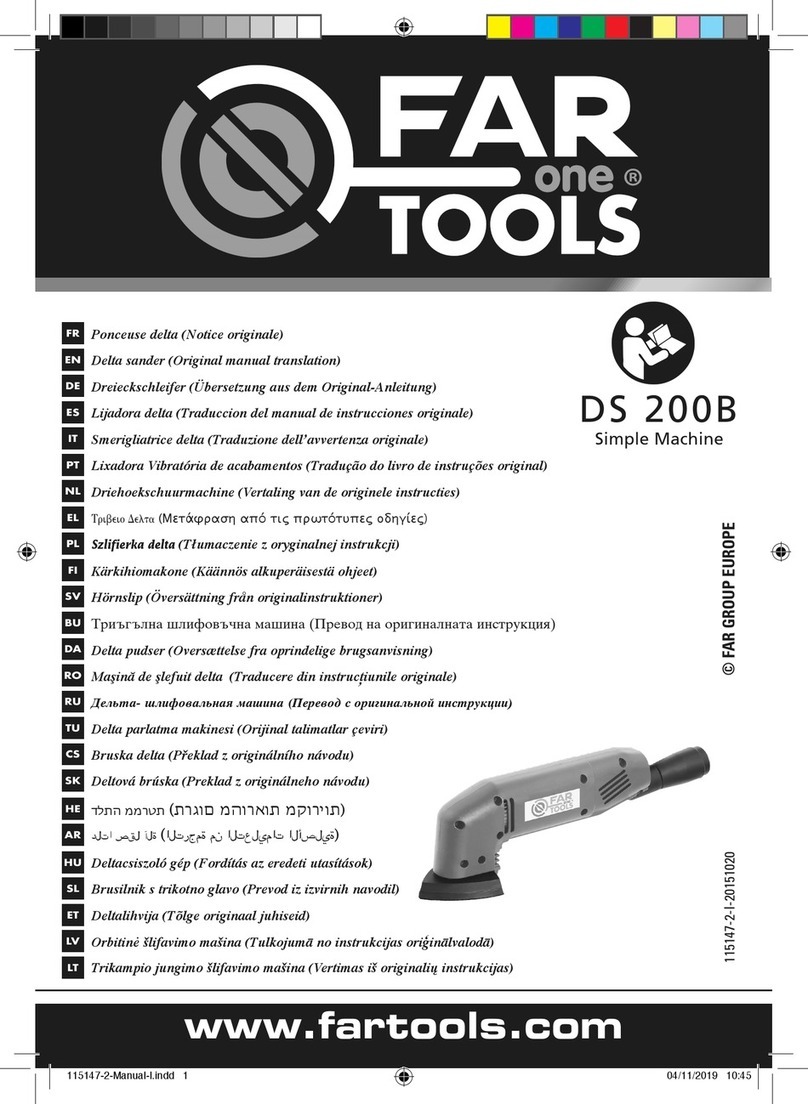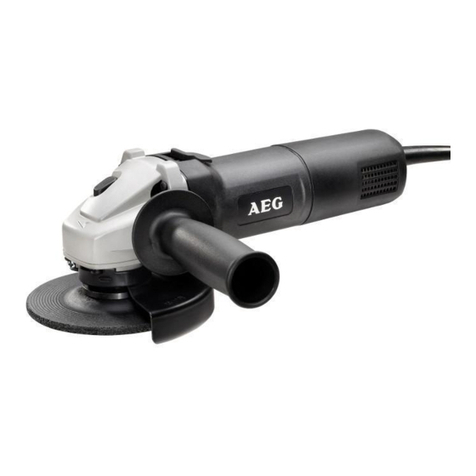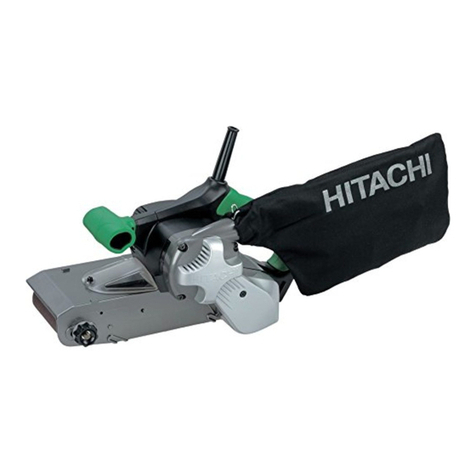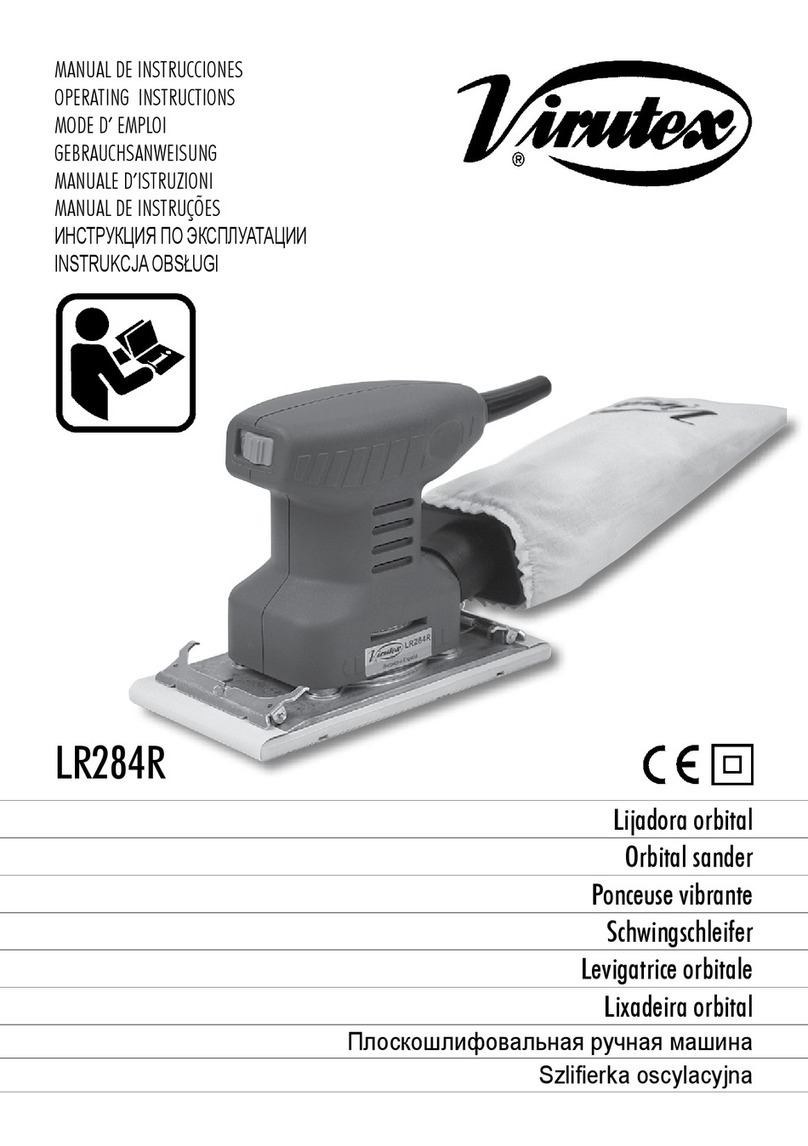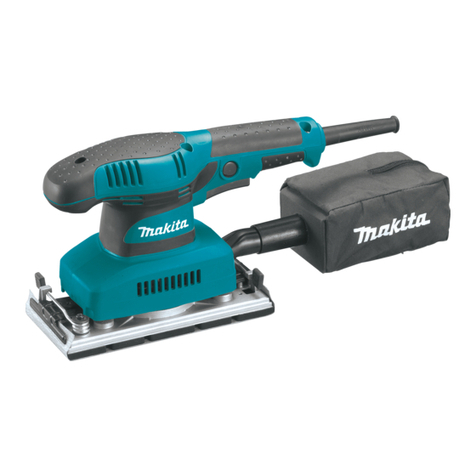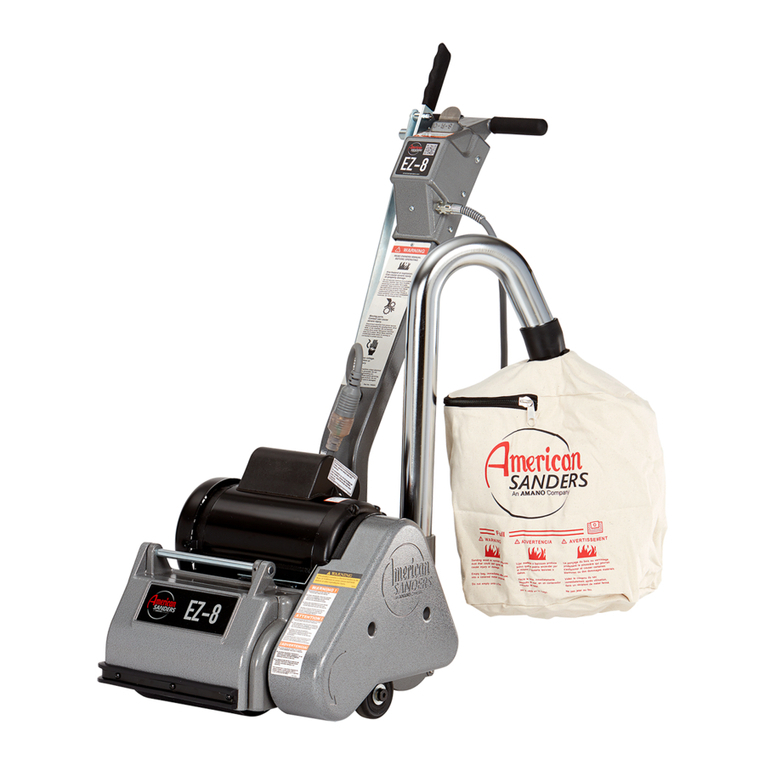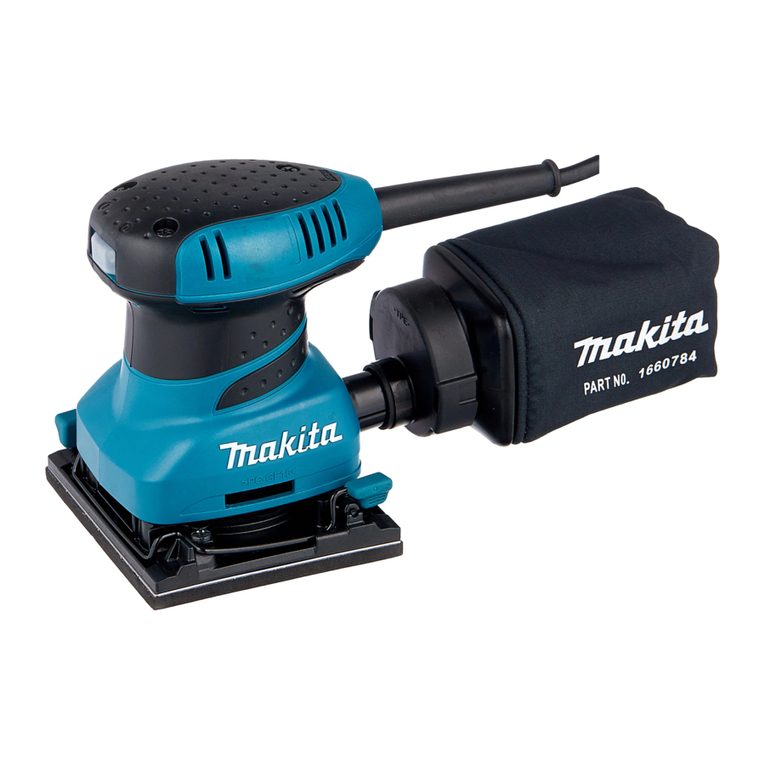Benchmark 1262-001 User manual

WEAR CSA APPROVED
EYE PROTECTION
WEAR EAR
PROTECTION
WEAR A
FACE MASK
READ ALL INSTRUCTIONS BEFORE FIRST USE.
KEEP THIS MANUAL FOR FUTURE REFERENCE.
KEEP AWAY FROM CHILDREN.
Maximum initial battery voltage (measured without a load)
is 20 volts. Nominal voltage is 18 volts.
20V MAX 5"
RANDOM ORBIT SANDER
5 Year Limited Warranty on tool
BATTERY AND CHARGER SOLD SEPARATELY
JD510720

1
PRODUCT SPECIFICATIONS
20V MAX 5" RANDOM ORBIT SANDER
Voltage 20v
3/32” Orbit Speed (3mm) VS 6,000-12,000 OPM
Sanding Sheet 5" (127mm)
Sanding Paper Attachment Hook & Loop
Tool Weight (without battery) 3.75lbs. (1.7kg)
Batteries (Sold Separately) 5350-023 (2.5Ah)
5350-011 (4Ah)
5350-012 (5Ah)
Charger (Sold Separately) 5350-010 2.4Amp
5350-022 6A Fast Charger
NEED ASSISTANCE?
Call us on our toll- free customer support line:
1-866-349-8665 (Monday through Friday 9am – 5pm Eastern Standard Time)
• Technical questions
• Replacement parts
• Parts missing from package

1262-001
20V MAX 5" RANDOM ORBIT SANDER
2
TABLE OF CONTENTS
Product Specifications................................................................................... 1
Table of Contents........................................................................................... 2
General Safety Warnings ................................................................................ 3
Eye, Ear & Lung Protection............................................................................. 3
General Safety Rules...................................................................................... 4
Power Tool Use and Care................................................................................ 5
Service .......................................................................................................... 6
Specific Safety Rules ..................................................................................... 6
Symbols......................................................................................................... 8
Know your 5” Radom Orbit Sander ................................................................. 9
Assembly..................................................................................................... 10
Operating .................................................................................................... 11
Maintenance ............................................................................................... 13
Exploded View ............................................................................................. 14
Parts Listing................................................................................................. 15
Warranty...................................................................................................... 16

3
GENERAL SAFETY WARNINGS
WARNING:
Before using this tool or any of its accessories, read this manual and follow all Safety
Rules and Operating Instructions. The important precautions, safeguards and
instructions appearing in this manual are not meant to cover all possible situations.
It must be understood that common sense and caution are factors which cannot be
built into the product.
EYE, EAR & LUNG PROTECTION
SYMBOL MEANING
ALWAYS WEAR EYE PROTECTION THAT CONFORMS WITH CSA
Z94.3 or ANSI SAFETY STANDARD Z87.1
FLYING DEBRIS can cause permanent eye damage. Prescription
eyeglasses ARE NOT a replacement for proper eye protection.
Non-compliant eyewear can cause serious injury if broken during
the operation of a power tool.
Use hearing protection, particularly during extended periods of
operation of the tool, or if the operation is noisy.
WEAR A DUST MASK THAT IS DESIGNED TO BE USED WHEN
OPERATING A POWER TOOL IN A DUSTY ENVIRONMENT.
Dust that is created by power sanding, sawing, grinding, drilling, and
other construction activities may contain chemicals that are known
to cause cancer, birth defects, or other genetic abnormalities. These
chemicals include:
• Lead from lead-based paints
• Crystalline silica from bricks, cement, and other masonry products
• Arsenic and chromium from chemically treated lumber.
The level of risk from exposure to these chemicals varies, according to
how often this type of work is performed. In order to reduce exposure
to these chemicals, work in a well-ventilated area, and use approved
safety equipment, such as a dust mask that is specifically designed to
filter out microscopic particles.
To avoid electrical hazards, fire hazards or damage to the tool,
use proper circuit protection.
This tool is wired at the factory for 120 Volts AC operation. It must be
connected to a 120 Volts AC, 15 Amps circuit that is protected by a
time-delayed fuse or circuit breaker. To avoid shock or fire, replace
power cord immediately if it is worn, cut or damaged in any way.

1262-001
20V MAX 5" RANDOM ORBIT SANDER
4
GENERAL SAFETY RULES
WARNING: Read all safety warnings and all instructions. Failure to follow the
warnings and instructions may result in electric shock, fire and/or serious injury.
Save all warnings and instructions for future reference.
WORK AREA SAFETY
Keep work area clean and well lit. Cluttered or dark areas invite accidents.
Do not operate power tools in explosive atmospheres, such as in the presence
of flammable liquids, gases or dust. Power tools create sparks which may ignite
the dust or fumes.
Keep children and bystanders away while operating a power tool.
Distractions can cause you to lose control.
ELECTRICAL SAFETY
Power tool plugs must match the outlet. Never modify the plug in any way.
Do not use any adapter plugs with earthed (grounded) power tools. Unmodified
plugs and matching outlets will reduce risk of electric shock.
Avoid body contact with earthed or grounded surfaces such as pipes, radiators,
ranges and refrigerators. There is an increased risk of electric shock if your body is
earthed or grounded.
Do not expose power tools to rain or wet conditions. Water entering a power tool
will increase the risk of electric shock.
Do not abuse the cord. Never use the cord for carrying, pulling or unplugging
the power tool. Keep cord away from heat, oil, sharp edges or moving parts.
Damaged or entangled cords increase the risk of electric shock.
When operating a power tool outdoors, use an extension cord suitable
for outdoor use. Use of a cord suitable for outdoor use reduces the risk of
electric shock.
If operating a power tool in a damp location is unavoidable, use a residual
current device (RCD) protected supply. Use of a ground fault circuit interrupter
(GFCI) protected supply. Use of a ground fault circuit interrupter (GFCI) reduces
the risk of electric shock.
PERSONAL SAFETY
Stay alert, watch what you are doing and use common sense when operating
a power tool. Do not use a power tool while you are tired or under the influence
of drugs, alcohol, or medication. A moment of inattention while operating power
tools may result in serious personal injury.
Use personal protective equipment. Always wear eye protection. Protective
equipment such as dust mask, non-skid safety shoes, hard hat, or hearing
protection used for appropriate conditions will reduce personal injuries.
connecting to power source and/or battery pack, picking up or carrying the
tool. Carrying power tools with your finger on the switch or energizing power tools
that have the switch on invites accidents.

5
Remove any adjusting key or wrench before turning the power tool on.
A wrench or a key left attached to a rotating part of the power tool may result
in personal injury.
Do not overreach. Keep proper footing and balance at all times. This enables
better control of the power tool in unexpected situations.
Dress properly. Do not wear loose clothing or jewellery. Keep your hair, clothing,
and gloves away from moving parts. Loose clothes, jewellery or long hair can be
caught in moving parts.
If devices are provided for the connection of dust extraction and collection
facilities, ensure these are connected and properly used. Use of dust collection
can reduce dust- related hazards.
POWER TOOL USE AND CARE
Do not force the power tool. Use the correct power tool for your application.
The correct power tool will do the job better and safer at the rate for which
it was designed.
Any power
tool that cannot be controlled with the switch is dangerous and must be repaired.
Disconnect the plug from the power source and/or the battery pack from the
power tool before making any adjustments, changing accessories, or storing
power tools. Such preventive safety measures reduce the risk of starting the
power tool accidentally.
Store idle power tools out of the reach of children and do not allow persons
unfamiliar with the power tool or these instructions to operate the power tool.
Power tools are dangerous in the hands of untrained users.
Maintain power tools. Check for misalignment or binding of moving parts,
operation. If damaged, have the power tool repaired before use.
Many accidents are caused by poorly maintained power tools.
Keep cutting tools sharp and clean. Properly maintained cutting tools with sharp
cutting edges are less likely to bind and are easier to control.
BATTERY TOOL USE AND CARE
1. Charge a rechargeable battery using only the charger recommended by the
manufacturer. Chargers are often designed for a particular type of rechargeable
battery unit. There is a risk of fire if a battery charger specified for a particular
type of battery is used with other batteries.
2. Only the rechargeable battery units supplied are to be used with an electrical
power tool. The use of other rechargeable battery units may lead to the danger
of injury or fire.
3. When they are not being used, store rechargeable battery units away from
paperclips, coins, keys, nails, screws or other small metal objects that could
cause the contacts to be bridged. Short circuiting the contacts of a rechargeable
battery unit may result in heat damage or fire.

1262-001
20V MAX 5" RANDOM ORBIT SANDER
6
4. Fluids may leak out of rechargeable battery units if they are misused. If this
with water. Seek additional medical help if any of the fluid gets into your eyes.
Escaping battery fluid may cause skin irritation or burns.
5. Do not use damaged or modified batteries. Damaged or modified batteries
may behave unexpectedly and cause fires, explosions or pose a risk of injury.
6. Do not expose a battery to fire or excessively high temperatures. Fire or
temperatures more than 130°C (265°F) can cause an explosion.
7. Follow all instructions regarding charging and never charge the battery or
the cordless tool outside of the temperature range given in the operating
instructions. Incorrect charging or charging outside of the permissible
temperature range can destroy the battery and increase the risk of fire.
SERVICE
Have your power tool serviced by a qualified repair person using only identical
replacement parts. This will ensure that the safety of the power tool is maintained.
SPECIFIC SAFETY RULES FOR RANDOM
ORBIT SANDER
WARNING: Know your random orbit sander. Do not plug in the sander until you
have read and understand this Instruction Manual. Learn the tool’s applications and
limitations, as well as the specific potential hazards related to this tool. Following
this rule will reduce the risk of electric shock, fire, or serious injury.
Always wear eye protection. Any power tool can throw foreign objects
into your eyes and cause permanent eye damage. ALWAYS wear
safety goggles (not glasses) that comply with ANSI safety standard
Z87.1. Everyday glasses have only impact resistant lenses.
They ARE NOT safety glasses.
WARNING: Glasses or goggles not in compliance with ANSI Z87.1
could cause serious injury when they break.
WARNING: Always use a dust mask when sanding.
WARNING: Always use hearing protection when sanding, particularly
during extended periods of operation.
WARNING: Always unplug the tool from the power source before
changing accessories, sandpaper and when cleaning the tool.
Do not wear gloves, neckties or loose clothing.
Secure the workpiece. Use clamps or a vise to hold the work when practical.
It is safer than using your hand and it frees both hands to operate the tool.
Do not sand material too small to be securely held.
Make sure there are no nails or foreign objects in the part of the workpiece
to be sanded.
Always keep hands out of the path of the sanding pad. Avoid awkward hand
positions where a sudden slip could cause your hand to move into the path
of the sanding pad.

7
To avoid injury from accidental starting, always remove the plug from the power
source before installing or removing dust box.
Do not rest your hands next to or in front of the sander and the area being worked as
there is a risk of injury if you slip.
RISK OF FIRE DUE TO FLYING SPARKS!
Sanding metal causes sparks to be produced. Therefore, make sure that nobody is
at risk and that no combustible materials are located in the immediate vicinity of
where you are working.
WARNING! TOXIC VAPOURS!
Working with the tool can produce harmful/ toxic dusts that represent a health
hazard for the person operating the appliance and for any other people in the area.
WARNING! RISKS DUE TO DUST!
When working for extended periods of time on wood and, in particular, materials
that produce dust that is hazardous to health, connect the appliance to a suitable
external dust extraction appliance. Wear safety goggles and a protective dust mask!
Avoid contact with sanding disc while the tool is running.
Never work on moistened or damp surfaces.
Do not use tool without the sanding disc attached.
Always allow the tool to come to a complete stop before putting the tool down.
Keep tool clean, dry and fee from oil or grease.
Use only the accessories provided and/or recommended by the manufacturer.

1262-001
20V MAX 5" RANDOM ORBIT SANDER
8
SYMBOLS
WARNING: Some of the following symbols may appear on the random orbit sander.
Study these symbols and learn their meaning. Proper interpretation of these symbols
V Volts n
~
Three-phase alternating
current with neutral
A Amperes Direct current
Hz Hertz noNo load speed
W Watts Alternating or direct current
kW Kilowatts Class II Construction
Microfarads Splash-proof construction
L Litres Watertight construction
kg Kilograms Protective grounding at
terminal, Class I tools
H Hours .../min Revolutions or
reciprocations per minute
N/cm² Newtons per
square centimetre Diameter
Pa Pascals 0
OPM Oscillation per minute Directional Arrow
Min Minutes Warning symbol
S Seconds Wear your safety glasses
~or AC Alternating current
~
Three-phase
alternating current
This symbol designates that this tool is listed with U.S. and Canadian requirements by
cTUVus Testing Laboratories, Inc.
UL62841-1,UL62841-2-4;
CSA C22.2#62841-1,CSA C22.2#62841-2-4.
JD510720
will allow

9
KNOW YOUR ORBIT SANDER
ON/OFF
Switch
Dust bag
Sanding Base
3 Sanding discs included
80g, 120g & 240g
Speed
Adjustment Dial
Battery (Sold
Separately)
Insert here

1262-001
20V MAX 5" RANDOM ORBIT SANDER
10
ASSEMBLY
INSTALLING THE DUST BAG ASSEMBLY
WARNING: Remove battery before assembly.
(1) Slide the dust bag into the back of the tool as far it will go (Fig. 1).
NOTE: Remove and clean the dust bag assembly often to remove accumulated
dust from the dust bag.
Fig 1
CLEANING THE DUST BAG
The dust bag will collect much of the sanding dust that is generated during sanding
operations. As a result, it must be cleaned out periodically so the dust collection
INSTALLING SANDPAPER
WARNING:
Remove the battery from the before installing or changing the sandpaper.
NOTE: Before fitting a new sanding disc on the tool, ensure you remove any dust
and/or dirt from sanding base.
1. To attach a sanding disc to your sander, face your sander upside down and
simply place the surface of the disc – which has the tiny loops – on the backing
pad, and employing pressure, press both surfaces together.
2. Ensure the extraction holes on the sanding disc match up with the holes
in the sanding base.

11
OPERATING
ON/OFF SWITCH
To turn the sander ON, ensure battery is charged and inserted into the back of
position. (Fig. 2)
Fig 2
SPEED ADJUSTMENT
Your orbital sander is equipped with a speed setting wheel. To set speed, turn speed
wheel to desired speed setting. Note, the lowest number equals the lowest speed
setting. The highest number is the highest speed.
SANDPAPER SELECTION
Selecting the correct grit and type of sandpaper is extremely important in achieving
a high- quality sanded finish. Aluminum oxide, silicon carbide and other synthetic
abrasives are best for power sanding. Natural abrasives such as flint and garnet are
too soft for economical use in power sanding. In general, coarse grit will remove the
most material and finer grit will produce the best finish in all sanding operations.
The condition of the surface to be sanded will determine which grit will do the best
job. If the surface is rough, start with a coarse grit and sand until the surface is
uniform. Medium grit may then be used to remove scratches left by the coarser grit.
Fine grit should be used for finishing the surface. Always continue sanding with each
grit until the surface is uniform.
WARNING: Always wear safety goggles or safety glasses with side shields when
operating your sander. Failure to do so could result in foreign objects being thrown
into your eyes resulting in possible serious eye damage.
Always wear an appropriate dust mask and hearing protection when
using your sander.

1262-001
20V MAX 5" RANDOM ORBIT SANDER
12
WARNING:
For safety reasons, the operator must read the sections of this Owner’s
Manual entitled “GENERAL SAFETY WARNINGS”, “POWER TOOL
SAFETY”, “SPECIFIC SAFETY RULES”, “EXTENSION CORD SAFETY”
and “SYMBOLS” before using this cut-out tool.
Verify the following every time the pad sander is used:
1. Safety glasses and dust mask are being worn.
2. Hearing protection is being worn.
3. Sandpaper is the correct type for the job.
Sandpaper is in good condition and is properly installed.
Failure to adhere to these safety rules can greatly increase the
chances of serious injury.
SANDING
Clamp or otherwise secure your workpiece to prevent it from moving under the
sander while being sanded.
WARNING: An unsecured workpiece could be thrown toward the operator
causing injury.
Place the sander on the workpiece so that the complete sandpaper surface is in
contact with the workpiece. Turn the sander ON by pressing on the side of the
ON/OFF switch. Move the sander slowly over workpiece making successive passes
in parallel lines, circles or crosswise movements.
Upon completion of the sanding operation, turn the sander OFF by pressing on the
opposite side of the ON/OFF switch. Wait until the sanding pad comes to a complete
stop before removing it from the workpiece.
WARNING: Your sander should only be turned ON when the entire surface
of the sanding pad is in contact with the workpiece. Failure to follow this sanding
procedure could result in loose sandpaper which could result in possible injury.
NOTE: Hold the sander using the grip on top of the sander. Be careful NOT to cover
the motor cooling vents with your hand. Motor damage may occur from over heating
if the cooling vents are covered.
DO NOT FORCE THE SANDER. The weight of the sander usually provides
adequate pressure. Let the sander and the sandpaper do the work. Applying added
pressure will slow the motor, increase the wear on the sandpaper and greatly reduce
the sander speed. Motor damage may occur if excessive downward pressure is
applied. It will also create an inferior finish on sanded work. Any finish or resin on
wood will soften from the frictional heat, causing the sandpaper to become clogged
very quickly. Do not sand in one spot too long as the sander’s rapid action may
remove too much material, making the surface uneven. Extended periods of sanding
may tend to overheat the motor. If this occurs, turn sander OFF, wait until the
sanding pad comes to a complete stop and remove it from the workpiece.
Check to make sure your hand has not been covering the cooling vents. Let the
motor cool before continuing the sanding operation.

13
MAINTENANCE
GENERAL
WARNING: When servicing, use only identical replacement parts. The use
of any other part may create a hazard or cause product damage.
DO NOT use solvents when cleaning plastic parts. Plastics are susceptible to
damage from various types of commercial solvents and may be damaged by their
use. Use a clean cloth to remove dirt, dust, oil, grease etc.
WARNING: Do not allow brake fluids, gasoline, petroleum-based products,
penetrating oils, etc. to come into contact with plastic parts. They contain
chemicals that can damage, weaken or destroy plastic.
DO NOT abuse power tools. Abusive practices can damage the tool and
the workpiece.
WARNING: DO NOT attempt to modify tools or create accessories.
Any such alteration or modification is misuse and could result in a hazardous
condition leading to possible serious injury. It will also void the warranty.
Remove accumulated dust and debris regularly using a soft DRY brush.
It has been found that electric tools are subjected to accelerated wear and
possible premature failure when they are used on fiberglass boats and sports
cars, wallboard, spackling compounds or plaster. The chips and grindings from
these materials are highly abrasive to electric tool parts such as bearings, brushes,
commutators, etc. Consequently, it is not recommended that this tool be used
for extended work on any fiberglass material, wallboard, spackling compounds or
plaster. During any use on these materials it is extremely important that the tool is
cleaned frequently by blowing it out with an air jet.
WARNING: Always wear safety goggles or safety glasses with side shields
during all sanding operations. It is critical that you also wear safety goggles or
safety glasses with side shields and a dust mask while blowing dust out of the
cut-out tool with an air jet. Failure to take these safety precautions could result
in permanent eye or lung damage.
LUBRICATION
amount of high grade lubricant for the life of the unit under normal conditions.
Therefore, no further lubrication is required.

1262-001
20V MAX 5" RANDOM ORBIT SANDER
14
EXPLODED VIEW

15
PARTS LIST
WARNING: When servicing, use only original equipment replacement parts.The
use of any other parts may create a safety hazard or cause damage to the sander .
Any attempt to repair or replace electrical parts on this sander may create a safety
hazard unless repairs are performed by a qualified technician.
For more information, call the Toll-free Helpline, at 1-866-349-8665
Monday – Friday from 9am to 5pm Eastern Standard Time.
Always order by PART NUMBER, not by key number.
Key # Part # Part Name Quantity
1 3140080054 SWITCH COVER
2 1061250001 SWITCH
3 2010170026 MAGNET
4 3140060073 ANTI-VIBRATION BAR
5 1030080021 785 MOTOR
6 3010040013 HOUSING Pair
7 3010040015 FOOT PLATE Pair
8 3140060076 RUBBER BAR
9 1130010291 PCB
10 2030220009 785 MOTOR FLANGE
11 4020010143 SCREW M4X8
12 2040050176 CONNECTING SHAFT
13 3140060031 ANTI-VIBRATION BAR
14 4010010054 BEARING 6000-2RS
15 2030020390 WASHER 65MN
16 3150010107 FAN
17 2030030315 BALANCE WEIGHT
18 2010130030 ECCENTRIC
19 2020130001 BEARING SEAT
20 2030170007 WASHER
21 4010010084 BEARING 6002-2RS
22 3150130172 PRESSURE PLATE
23 2030020033 WASHER
24 4040030011 WASHER
25 40200800 7 5 SCREW
26 4030010174 SCREW ST3.9X8
27 2030030238 AUXILIARY BALANCE WEIGHT
28 3190010058 WOOL FELT (WIDTH 7.3M BLACK)

1262-001
20V MAX 5" RANDOM ORBIT SANDER
16
Key # Part # Part Name Quantity
29 1150020153 PLATE
30 4020010142 SCREW M5X14
31 4030010106 SCREW ST3.9X19
32 3150170016 TERMINAL PLATE
33 3180060023 HOLDER
34 3180040130 DUST BAG
WARRANTY
BENCHMARK RANDOM ORBIT SANDER
If this Benchmark Tool fails due to a defect in material or workmanship within 5
years from the date of purchase, return it to any Home Hardware store with the
warranty does not include expendable parts including but not limited to blades,
brushes, belts, light bulbs. This warranty covers defects in material or workmanship
commercial or rental purposes, this warranty does not apply.

17

1262-001
20V MAX 5" RANDOM ORBIT SANDER
18

WEAR CSA APPROVED
EYE PROTECTION
WEAR EAR
PROTECTION
WEAR A
FACE MASK
Made in China
1262-001
BENCHMARK TOOLS CANADA
ST. JACOBS, ONTARIO N0B 2N0
©01 / 2021 Home Hardware Stores Limited
TM
MC
CUSTOMER SERVICE/TECH SUPPORT
1-866-349-8665
READ ALL INSTRUCTIONS BEFORE FIRST USE.
KEEP THIS MANUAL FOR FUTURE REFERENCE.
KEEP AWAY FROM CHILDREN.
Maximum initial battery voltage (measured without a load)
is 20 volts. Nominal voltage is 18 volts.
* This BenchmarkTM product carries a five (5) year LIMITED warranty against defects
in workmanship and materials. The charger and batteries carry a three (3) year
LIMITED warranty. See Owner’s Manual for full details.
5 Year Limited Warranty on tool
BATTERY AND CHARGER SOLD SEPARATELY
20V MAX 5"
RANDOM ORBIT SANDER
JD510720
Table of contents
Other Benchmark Sander manuals
